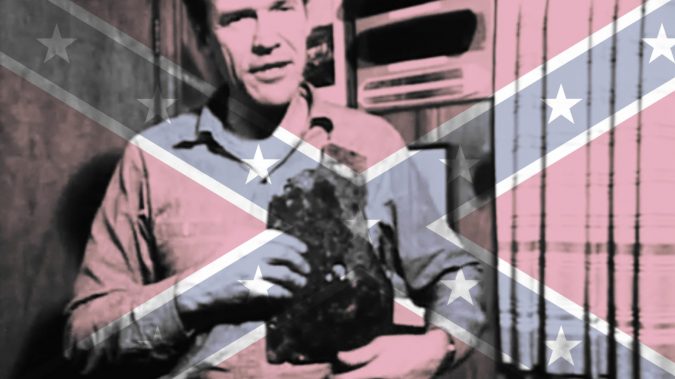The great Atlanta newspaperman Ralph McGill, writing in the tumultuous 1950s and 1960s, used to say “there are many Souths,” and in my family, I might say, there are many Southerners, none of them quite the same.
They are a baffling and occasionally shameful array of people whose motives and attitudes are impossible to compress into any one category. In the old days they were Confederates and Unionists (one great-great-grand-uncle in the hills of North Georgia was named William Tecumseh Sherman Dickey). They were slave owners and dirt farmers, a gandy-dancer on the railroad, and a wealthy snake-oil salesman (with a sure cure for syphilis!). More recently, there was a modern-day Civil War ordnance expert, my uncle; and the poet-novelist author of Deliverance, my father, who, as it happens, also played the genteel “redneck” sheriff in the movie.
Based on years of research, it takes a close look at the self-destructive Confederate madness in the epicenter of secession through the eyes of a relatively impartial observer, Her Majesty Queen Victoria’s consul in South Carolina, Robert Bunch, who reported to the Crown in bitter, cynical detail on the way the slave-owning elite inspired and led hundreds of thousands of people to their deaths in defense of an indefensible institution.
There is nothing complicated about racism, I realized. All that is complicated is the way excuses are made for it in the North as well as the South.
The more I have learned over the years about my own family, meanwhile, the more I have come to appreciate the diversity as well as the perversity of a very Southern heritage.
Family lore had it that my father’s mother’s father, a Rebel colonel, I was told, raised a defiant Confederate flag of some sort over one of the surviving buildings in Atlanta after the Federals burned the city. He went on to make a fortune selling a supposed cure for venereal disease, which he happily peddled to people of every race. On my father’s father’s side, the towering figure in the family was Hannah Dickey, one of the few slave owners in the hills of Fannin County, Georgia. She is buried on Hogback Mountain in the same plot with several of the people she owned. Yet she was not a Confederate; she was a Unionist, who named one of her many sons William Tecumseh Sherman Dickey after the Union general who cut a swath of flames and destruction through Georgia to the sea. My mother’s family was from west Tennessee, the Confederate part of the state, and in the 1970s I read a report that the bodies of two Union soldiers had been found in the old family house during a remodeling.
But the most vivid of my Civil War “memories” are associated with my late uncle, Tom Dickey, who was not crazy, really, but who certainly was passionate about the Civil War. Or rather, he was passionate about its guns and bullets and cannonballs and shells. Nobody in the world knew more about Confederate and Federal artillery projectiles than Tom, because from the 1950s to the 1980s he went all over obscure battlefields every chance he got, from suburban Atlanta to South Carolina swamps and Louisiana backwaters, searching with a World War II mine detector for the long-buried armaments that men had used to slaughter each other in the War Between the States.
My father, James Dickey, the poet and novelist, found it fascinating that his brother tried to “enter the past through its munitions,” and wrote a moving poem called “Hunting Civil War Relics at Nimblewill Creek,” about searching with Tom through a forgotten killing field and watching the battle, in a sense, by watching Tom’s expression as the pulse of the mine detector told him what lay beneath the surface: “The dead have waited here a hundred years to create only the look on the face of my one brother, who stands among them, offering a metal dish afloat in the trembling weeds.”
When I was a kid making documentary films in the 1970s, my friend David Goldenberg and I produced one about Tom and his obsession that tried to get at the basic question of how we in the South remembered the Civil War.
WAR UNDER THE PINESTRAW (VIDEO)
I had discovered a couple of years earlier at the Library of Congress the vast trove of photographs from the battlefields that were rarely if ever published in those days, many of them gruesome pictures of dead and bloated bodies, several of them printed on 3-D stereo cards. I thought I could use those images and Tom’s obsession to tell a story contrasting an eccentric hobby and the real horror of the war.
In the event, Tom’s Southern charm took over, and the climax of the film—the defusing of a 100-pound shell in his basement with a sponge, a screwdriver, and a hammer—is unforgettable for reasons I hadn’t originally intended. But that film, posted above and here, was my first try at reconciling the way we think about war and talk about war, and the way war actually is, which is something I’ve since spent most of my life trying to understand and explain as a foreign correspondent covering modern conflicts in several different parts of the world.
At the end of the film, we’re in Tom’s backyard at night on a quiet suburban street in Atlanta when he lights some powder from one of his shells. The flame casts a strange glow on his face. “I do worry about it sometimes,” he says. “If this house caught on fire, it could do a lot of damage around the neighborhood. You’d hear the last shots fired during the Civil War.”
Tom died of natural causes in 1987. His house never did catch on fire and the shells were destroyed or moved to a museum. But the last shots fired in the Civil War, sadly, do continue to be heard.
–thedailybeast.com



